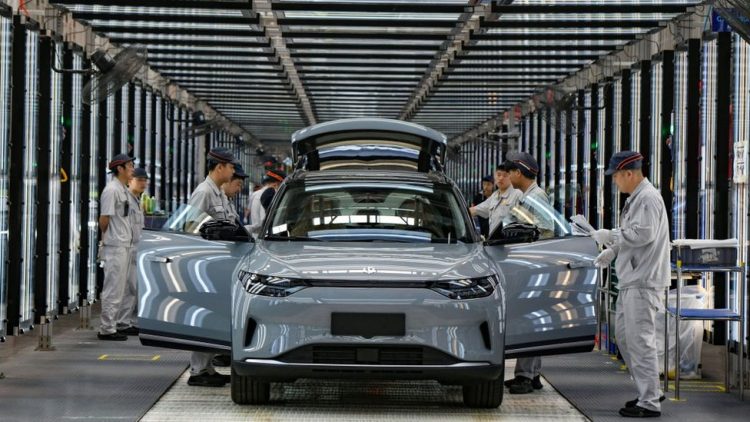Introduction: The Urgency of Climate Change Mitigation
Climate change is one of the most pressing challenges facing the world today. The consequences of global warming—rising sea levels, extreme weather events, and the disruption of ecosystems—are already being felt across the globe. The scientific consensus is clear: to avoid the worst impacts of climate change, humanity must drastically reduce greenhouse gas (GHG) emissions and transition to a more sustainable, low-carbon economy. Among the most significant contributors to these emissions is the transportation sector, which accounts for nearly 25% of global CO2 emissions, according to the Intergovernmental Panel on Climate Change (IPCC).
One of the most promising solutions to mitigating climate change lies in the adoption of electric vehicles (EVs). Electric vehicles have the potential to drastically reduce the transportation sector’s carbon footprint, thereby contributing to climate change mitigation efforts. This article will explore how the widespread adoption of EVs can help reduce GHG emissions, decrease dependence on fossil fuels, and support the transition to a more sustainable future.
The Role of Transportation in Climate Change
The transportation sector, including road, air, and maritime transport, is a major contributor to global greenhouse gas emissions. The burning of fossil fuels in internal combustion engine (ICE) vehicles is the primary source of emissions in this sector. Cars, trucks, buses, and other forms of transportation emit large quantities of carbon dioxide (CO2) and other pollutants, such as nitrogen oxides (NOx) and particulate matter (PM), which contribute to air pollution and global warming.
In many countries, particularly developed nations, the private car is the primary mode of transportation, further amplifying the sector’s environmental impact. As the global population grows and urbanization increases, the demand for transportation will continue to rise, making the need for cleaner, more sustainable alternatives even more urgent.
The transition to electric vehicles represents one of the most effective ways to address the environmental challenges posed by the transportation sector. By shifting from fossil fuel-powered vehicles to EVs, we can reduce the reliance on oil, lower emissions, and help prevent further climate damage.
How Electric Vehicles Help Mitigate Climate Change
1. Zero Tailpipe Emissions
One of the most significant environmental benefits of electric vehicles is their zero tailpipe emissions. Internal combustion engine vehicles release large amounts of carbon dioxide (CO2) and other harmful pollutants directly into the atmosphere. These pollutants contribute to the greenhouse effect and exacerbate climate change. In contrast, electric vehicles produce no tailpipe emissions, making them an essential tool in reducing global carbon emissions.
By replacing traditional gasoline and diesel-powered vehicles with EVs, cities and countries can significantly lower their overall emissions. Even in regions where the grid relies on fossil fuels for electricity generation, the emissions associated with EVs tend to be lower than those from conventional vehicles because of the higher efficiency of electric motors compared to internal combustion engines.
The zero-emissions nature of EVs makes them an important part of the strategy for achieving net-zero emissions by mid-century. The more EVs on the road, the fewer emissions will be produced, which directly contributes to the reduction of global warming.
2. Reducing Dependence on Fossil Fuels
Electric vehicles also help reduce the world’s dependence on fossil fuels, a major driver of climate change. The burning of oil, coal, and natural gas for energy production is responsible for the majority of global greenhouse gas emissions. Fossil fuels are finite resources, and their extraction, transport, and use have severe environmental and geopolitical consequences.
As electric vehicles become more widespread, they help diversify energy sources and reduce the demand for oil and other fossil fuels. EVs are powered by electricity, which can be generated from a variety of sources, including renewable energy such as solar, wind, and hydroelectric power. This diversification of energy sources helps stabilize energy markets and reduce reliance on non-renewable resources.
The use of renewable energy to charge EVs enhances their environmental benefits. As the global energy grid transitions to cleaner energy sources, the carbon footprint of EVs continues to decrease, further contributing to climate change mitigation. In the long term, the widespread adoption of electric vehicles can help phase out fossil fuel use and accelerate the shift to a more sustainable energy system.
3. Higher Energy Efficiency
Electric vehicles are much more energy-efficient than conventional gasoline or diesel vehicles. Internal combustion engine vehicles waste a significant amount of energy in the form of heat and friction. According to the U.S. Department of Energy, conventional vehicles convert only about 12-30% of the energy from fuel into actual motion, while the rest is lost to heat and friction. In contrast, electric vehicles convert around 85-90% of the energy from the battery to power the wheels, making them far more efficient.
This higher energy efficiency translates into a lower overall carbon footprint. Because EVs use less energy to travel the same distance, they produce fewer emissions, even when accounting for the energy used to generate the electricity they consume. The greater the efficiency of electric vehicles, the greater the reduction in emissions.
Additionally, as renewable energy technologies continue to evolve and become more cost-effective, the energy efficiency of EVs will become even more pronounced. The combination of clean electricity and efficient electric motors will make EVs an even more attractive option for reducing carbon emissions in the transportation sector.
4. Lifecycle Emissions and Sustainability
It is essential to consider the full lifecycle emissions of electric vehicles to understand their environmental impact. While the manufacturing of electric vehicles, particularly the production of their batteries, can result in higher emissions than the production of conventional vehicles, the overall lifecycle emissions of EVs are still significantly lower.
Studies show that over the lifetime of a vehicle, electric vehicles produce fewer emissions than gasoline or diesel vehicles. The initial emissions from the production phase are offset by the lower emissions produced during the vehicle’s operational phase. As battery technology improves and manufacturing processes become more efficient, the carbon footprint associated with EV production is expected to decrease.
Additionally, the recycling of EV batteries and the development of second-life applications (such as using used EV batteries for energy storage) will further reduce the environmental impact of electric vehicles. Innovations in battery recycling and materials recovery will make EVs even more sustainable in the future.
5. Decarbonizing the Transport Sector
The transport sector is one of the hardest to decarbonize, due to the widespread reliance on fossil fuel-powered vehicles. However, the electrification of transportation—through the adoption of electric vehicles, electric buses, trucks, and even electric ships and planes—represents a major opportunity to reduce emissions across the entire sector. EVs play a central role in decarbonizing the transport sector, and their widespread adoption is a critical step in achieving global climate goals.
Governments around the world have recognized the importance of electrifying transportation and are implementing policies to encourage EV adoption. These policies include incentives, subsidies, and mandates aimed at increasing the availability and affordability of EVs. In addition, countries are investing in the infrastructure needed to support EVs, such as charging stations and smart grids, to facilitate the transition to electric mobility.
By electrifying transportation, we can reduce dependence on fossil fuels, lower emissions, and help create a cleaner, more sustainable global economy.

Global Efforts and Policy Support for EV Adoption
Governments, international organizations, and private companies are working together to accelerate the adoption of electric vehicles. Policies aimed at mitigating climate change through the promotion of EVs are being implemented across the globe. These policies range from financial incentives to regulatory frameworks that mandate the reduction of emissions from vehicles.
1. Government Incentives and Subsidies
One of the primary drivers of EV adoption is government incentives, including subsidies, tax credits, and rebates. These financial incentives help reduce the upfront cost of electric vehicles, making them more affordable for consumers. In many countries, governments are offering significant incentives to encourage individuals and businesses to purchase EVs.
In addition to consumer incentives, governments are also investing in charging infrastructure and providing funding for research and development in EV technology. The expansion of EV charging networks is crucial to ensuring that electric vehicles are practical for everyday use.
2. Regulations and Emission Standards
Governments are also enacting stricter emission standards to reduce the environmental impact of vehicles. In many countries, regulations are being introduced that require automakers to meet ambitious fuel efficiency standards and reduce the emissions of their vehicles. These regulations are pushing automakers to invest in electric vehicle technology and accelerate the development of low-emission vehicles.
In some regions, governments have set deadlines for the phase-out of internal combustion engine vehicles. For example, countries like Norway and the United Kingdom have announced plans to ban the sale of new gasoline and diesel vehicles by 2035, further accelerating the transition to electric vehicles.
3. International Agreements and Climate Commitments
At the international level, agreements such as the Paris Agreement play a vital role in promoting EV adoption. Countries around the world have committed to reducing their greenhouse gas emissions and limiting global temperature rise to well below 2°C. The transition to electric vehicles is a key component of these climate commitments, as it directly contributes to reducing emissions from the transportation sector.
International organizations, such as the International Energy Agency (IEA), are working to promote the global adoption of electric vehicles through research, policy guidance, and technical assistance. These efforts help create a global framework for EV adoption and ensure that all countries are working toward the same goal of climate change mitigation.
The Future of Electric Vehicles and Climate Change Mitigation
The widespread adoption of electric vehicles represents a critical opportunity to mitigate climate change and reduce global greenhouse gas emissions. As technology improves and costs decrease, EVs will become more accessible and affordable for consumers worldwide. The integration of renewable energy into the grid, the expansion of charging infrastructure, and the continued development of advanced battery technology will further enhance the environmental benefits of electric vehicles.
Electric vehicles are a crucial part of the transition to a low-carbon economy, and their widespread adoption will be essential for meeting global climate goals. By reducing emissions, decreasing dependence on fossil fuels, and improving energy efficiency, electric vehicles can help mitigate climate change and create a cleaner, more sustainable future.











































